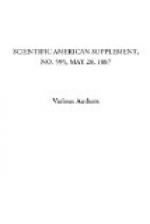Apart from the question of its singular mode of origin, however, and its remarkable and anomalous physical properties, tabasheer is of much interest to mineralogists and geologists. All the varieties hitherto examined, with the exception of the peculiar one from the Andes, are in composition and physical characters true opals. This is the case with all the Indian and Java varieties. They consist essentially of silica in its colloidal form, the water, lime, potash, and organic matter being as small and variable in amount as in the mineral opals; and, as in them, these substances must be regarded merely as mechanical impurities.
The tabasheers must be studied in their relations on the one hand with certain varieties of the natural semi-opals, hydrophanes, beekites, and floatstones, some of which they closely resemble in their physical characters, and on the other hand with specimens of artificially deposited colloid silica formed under different conditions. Prof. Church, who has so successfully studied the beekites, informs me that some of those remarkable bodies present singular points of analogy with tabasheer.
By the study of thin sections I have, during several years, been endeavoring to trace the minute structure of some of these substances. In no class of materials is it more necessary to guard one’s self against errors of observation arising from changes induced in the substance during the operations which are necessary to the preparation of transparent sections of hard substances. Unfortunately, too, it is the custom of the natives to prepare the substance for the market by an imperfect calcination, and hitherto I have only been able to study specimens procured in the markets which have been subjected to this process. It is obviously desirable, before attempting to interpret the structures exhibited, under the microscope, to compare the fresh and uncalcined materials with those that have been more or less altered by heat.
Tabasheer would seem, from Brewster’s experiments, to be a very intimate admixture of two and a half parts of air with one part of colloidal silica. The interspaces filled with air appear, at all events, in most cases, to be so minute that they cannot be detected by the highest powers of the microscope which I have been able to employ. It is this intimate admixture of a solid with a gas which probably gives rise to the curious and anomalous properties exhibited by this singular substance.
The ultra-microscopical vesicles filled with air in all probability give rise to the opalescence which is so marked a property of the substance. Their size is such as to scatter and throw back the rays at the blue end of the spectrum and to transmit those at the red end.
When the vesicles of the substance are filled with Canada balsam, and a thin slice is cut from it, this opalescence comes out in the most striking manner. Very thin sections are of a rich orange yellow by transmitted light, and a delicate blue tint by reflected light. I do not know of any substance which in such thin films displays such striking opalescence.




